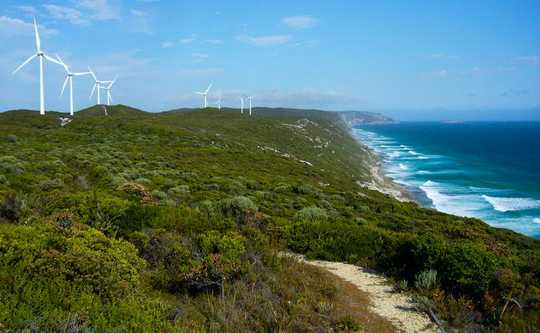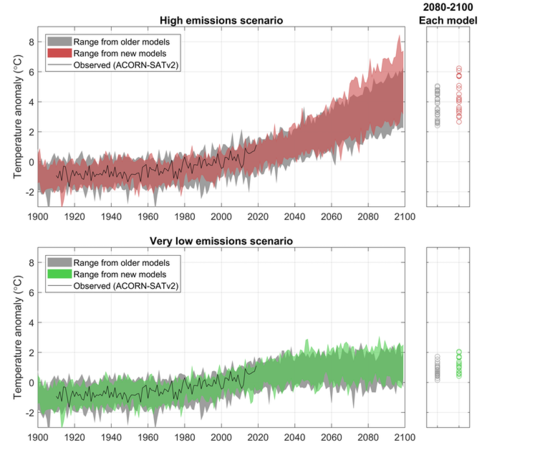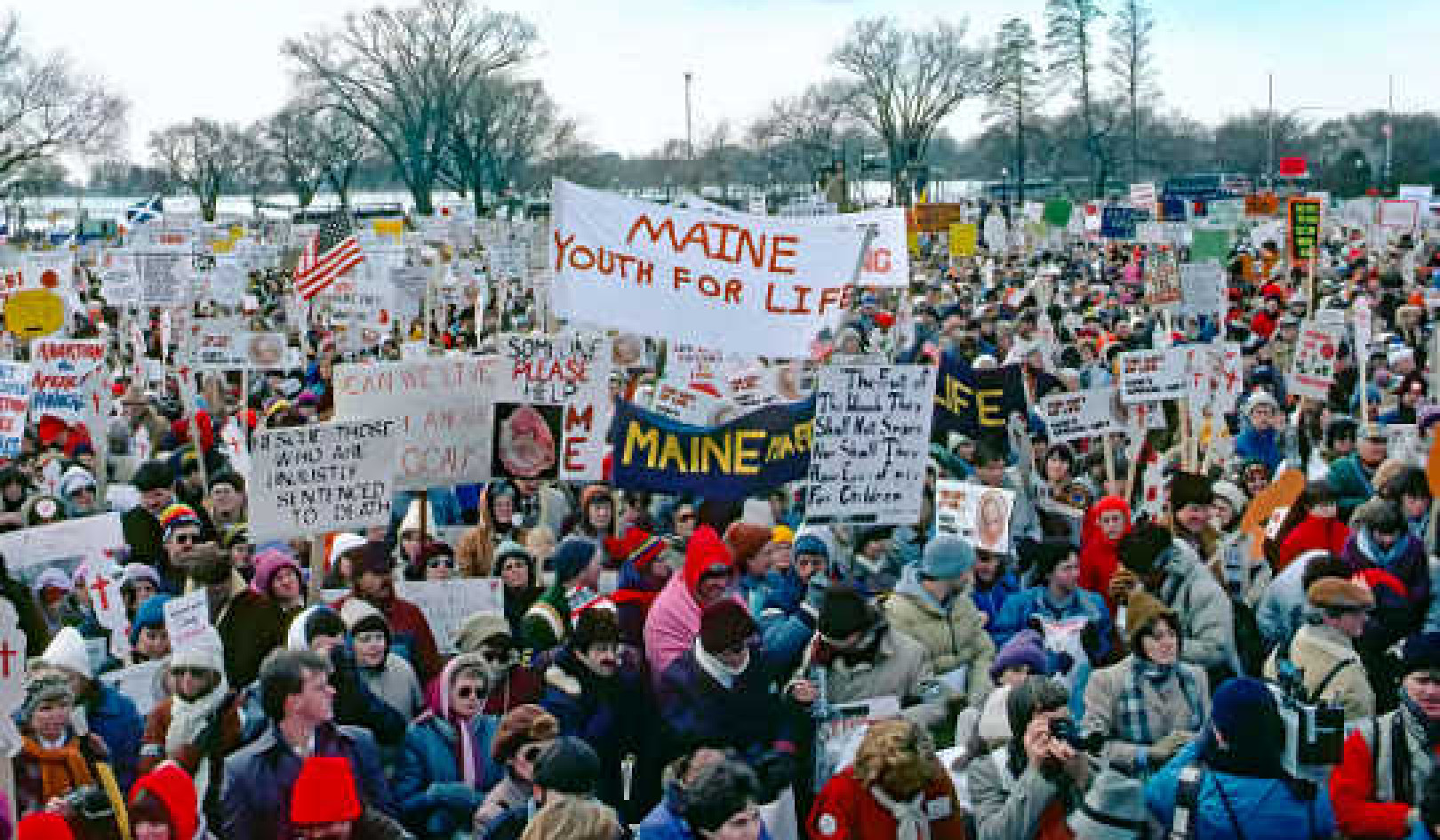
Climate scientists use mathematical models to project the Earth’s future under a warming world, but a group of the latest models have included unexpectedly high values for a measure called “climate sensitivity”.
Climate sensitivity refers to the relationship between changes in carbon dioxide in the atmosphere and warming.
The high values are an unwelcome surprise. If they’re right, it means a hotter future than previously expected – warming of up to 7? for Australia by 2100 if emissions continue to rise unabated.
Our recent study analyses these climate models (named CMIP6), which were released at the end of last year, and what insights they give for Australia.
These models contain the latest improvements and innovations from some of the world’s leading climate modelling institutes, and will feed into the Intergovernmental Panel on Climate Change (IPCC) Sixth Assessment Report in 2021.
But the new climate sensitivity values raise the question of whether previous climate modelling has underestimated potential climate change and its effects, or whether the new models are overdoing things.
If the high estimate is right, this would require the world to make greater and more urgent emission cuts to meet any given warming target.
 These higher climate sensitivity values point to the urgent need to cut our greenhouse gas emissions. Shutterstock
These higher climate sensitivity values point to the urgent need to cut our greenhouse gas emissions. Shutterstock
What is climate sensitivity?
Climate sensitivity is one of the most important factors for climate change, strongly influencing our planning for adaptation and mitigation of greenhouse gas emissions.
It’s a standardised measure of how much the climate responds when carbon dioxide concentrations in the atmosphere double. There are a few indices of climate sensitivity that the scientific community uses, and perhaps the most commonly used is “equilibrium climate sensitivity”.
We can estimate equilibrium climate sensitivity by raising carbon dioxide concentrations in models abruptly and then calculating the warming experienced after 150 years – when the atmosphere and ocean would return to a temperature balance.
In other words, giving the climate a “push” with more carbon emissions and waiting until it settles down into a new state.
The previous generation of models (CMIP5) had equilibrium climate sensitivity values between 2.1? to 4.7? global temperature change. The values for the latest models (CMIP6) are from 1.8? to 5.6?.
This includes a cluster of models with sensitivity of 5? or more, a group of models within the previous range, and two models with very low values at around 2?.
What this means for our future
Higher equilibrium climate sensitivity values mean a hotter future climate than previously expected, for any given scenario of future emissions.
 We’ll see Australian temperature increase in a low and high emissions scenario projections (temperature relative to 1995-2014, range of models shown as coloured bands, observations as a black line). Author provided
We’ll see Australian temperature increase in a low and high emissions scenario projections (temperature relative to 1995-2014, range of models shown as coloured bands, observations as a black line). Author provided
According to these new models, Australian warming could crack more than 7? by 2100 under a scenario where greenhouse gas emissions continue to increase through the century.
These higher temperature changes are not currently presented in the national climate projections, as they didn’t occur under the previous generation of models and emission scenarios.
So what does this mean in practice?
Higher climate sensitivity means increases to heat extremes. It would mean we’ll see greater flow-on changes to other climate features, such as extreme rainfall, sea level rise, extreme heatwaves and more, reducing our ability to adapt.
High equilibrium climate sensitivity would also mean we need to make bigger cuts to our greenhouse gas emissions for a given global warming target. The Paris Agreement aims to keep global warming well under 2? since pre-industrial times.
Should we be worried?
These are credible models, representing the new generation versions of top performing modelling systems, developed over decades at high-ranking research institutions globally. Their results cannot be rejected out of hand just because we don’t like the answer.
But – we shouldn’t jump on this piece of evidence, throw out all others and assume the results from a subset of new models is the final answer.
The weight and credibility of each piece of evidence must be carefully assessed by the research community, and by scientists putting together the upcoming IPCC assessment.
We’re only just starting to understand the reasons for the high sensitivity in these models, such as how clouds interact with particles in the air.
And there are other lines of evidence underpinning the IPCC estimate of equilibrium climate sensitivity.
These include the warming seen since the last ice age around 20,000 years ago; measurements of warming seen over recent decades from greenhouse gases already emitted; and understanding different climate feedbacks from field experiments and observed natural variability. These other lines of evidence may not support the new model results.
Essentially, the jury is still out on the exact value of equilibrium climate sensitivity, high values can’t be ruled out, and the results from the new models need to be taken seriously.
In any case, the new values are a worrying possibility that no one wants, but one we must still grapple with. As researchers in one study conclude: “what scares us is not that the models’ [equilibrium climate sensitivity] is wrong […] but that it might be right”.![]()
About The Author
Michael Grose, Climate Projections Scientist, CSIRO and Julie Arblaster, Associate Professor, Monash University
This article is republished from The Conversation under a Creative Commons license. Read the original article.
Related Books
Life After Carbon: The Next Global Transformation of Cities
by Peter Plastrik , John Cleveland The future of our cities is not what it used to be. The modern-city model that took hold globally in the twentieth century has outlived its usefulness. It cannot solve the problems it helped to create—especially global warming. Fortunately, a new model for urban development is emerging in cities to aggressively tackle the realities of climate change. It transforms the way cities design and use physical space, generate economic wealth, consume and dispose of resources, exploit and sustain the natural ecosystems, and prepare for the future. Available On Amazon
The future of our cities is not what it used to be. The modern-city model that took hold globally in the twentieth century has outlived its usefulness. It cannot solve the problems it helped to create—especially global warming. Fortunately, a new model for urban development is emerging in cities to aggressively tackle the realities of climate change. It transforms the way cities design and use physical space, generate economic wealth, consume and dispose of resources, exploit and sustain the natural ecosystems, and prepare for the future. Available On Amazon
The Sixth Extinction: An Unnatural History
by Elizabeth Kolbert Over the last half-billion years, there have been Five mass extinctions, when the diversity of life on earth suddenly and dramatically contracted. Scientists around the world are currently monitoring the sixth extinction, predicted to be the most devastating extinction event since the asteroid impact that wiped out the dinosaurs. This time around, the cataclysm is us. In prose that is at once frank, entertaining, and deeply informed, New Yorker writer Elizabeth Kolbert tells us why and how human beings have altered life on the planet in a way no species has before. Interweaving research in half a dozen disciplines, descriptions of the fascinating species that have already been lost, and the history of extinction as a concept, Kolbert provides a moving and comprehensive account of the disappearances occurring before our very eyes. She shows that the sixth extinction is likely to be mankind's most lasting legacy, compelling us to rethink the fundamental question of what it means to be human. Available On Amazon
Over the last half-billion years, there have been Five mass extinctions, when the diversity of life on earth suddenly and dramatically contracted. Scientists around the world are currently monitoring the sixth extinction, predicted to be the most devastating extinction event since the asteroid impact that wiped out the dinosaurs. This time around, the cataclysm is us. In prose that is at once frank, entertaining, and deeply informed, New Yorker writer Elizabeth Kolbert tells us why and how human beings have altered life on the planet in a way no species has before. Interweaving research in half a dozen disciplines, descriptions of the fascinating species that have already been lost, and the history of extinction as a concept, Kolbert provides a moving and comprehensive account of the disappearances occurring before our very eyes. She shows that the sixth extinction is likely to be mankind's most lasting legacy, compelling us to rethink the fundamental question of what it means to be human. Available On Amazon
Climate Wars: The Fight for Survival as the World Overheats
by Gwynne Dyer Waves of climate refugees. Dozens of failed states. All-out war. From one of the world’s great geopolitical analysts comes a terrifying glimpse of the strategic realities of the near future, when climate change drives the world’s powers towards the cut-throat politics of survival. Prescient and unflinching, Climate Wars will be one of the most important books of the coming years. Read it and find out what we’re heading for. Available On Amazon
Waves of climate refugees. Dozens of failed states. All-out war. From one of the world’s great geopolitical analysts comes a terrifying glimpse of the strategic realities of the near future, when climate change drives the world’s powers towards the cut-throat politics of survival. Prescient and unflinching, Climate Wars will be one of the most important books of the coming years. Read it and find out what we’re heading for. Available On Amazon
From The Publisher:
Purchases on Amazon go to defray the cost of bringing you InnerSelf.comelf.com, MightyNatural.com, and ClimateImpactNews.com at no cost and without advertisers that track your browsing habits. Even if you click on a link but don't buy these selected products, anything else you buy in that same visit on Amazon pays us a small commission. There is no additional cost to you, so please contribute to the effort. You can also use this link to use to Amazon at any time so you can help support our efforts.
























